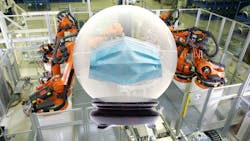At a time when a company’s current product line isn’t selling, a good business leader will look for ways to repurpose their equipment to produce what is in demand. But, for most manufacturers, having the capability to retool is an exception, not the rule. Manufacturers considering a shift to making personal protective equipment (PPE), complex machinery such as ventilators and other COVID-19-related gear are discovering how difficult switching production can be.
The core reason tackling a new product is so difficult is that manufacturing inherently is a process in which change and variation are the enemies. Additionally, most manufacturing equipment are specifically designed and tuned to perform tasks for a particular product, package or size. A labeler designed to put labels on one-liter vodka bottles may have trouble doing the same on a two-ounce hand sanitizer. The most efficient, safest and highest-quality way to manufacture anything is to agree on what the product is (with clearly defined specifications), set up the best equipment and processes for making it, and then effectively monitor the machine health and maintenance of the equipment used to produce it.
Since long, stable production runs are ideal, changing a process, product or scheduling can result in greater variability, higher costs, more safety risks and reduced quality. Shifting to making something different, therefore, implies that the least different the new product is from the current one and the fewer changes that have to be made, the easier, faster and better the outcome will be. Even when the product lines are similar, unforeseen issues often crop up during trial runs resulting in additional equipment adjustments and changes.
For example, hand-sanitizing liquids—much in demand to combat COVID-19—are not much different from other alcohol-based liquids. If a company were manufacturing and packaging an alcohol-based liquid, switching to making hand sanitizers probably would not be too difficult. In fact, that’s exactly what has happened.
The website of the Distilled Spirits Council of the United States, the trade group of domestic liquor manufacturers, has a long list of its members that have converted some of their production to making disinfectant sanitizers. No doubt, in order to simplify production and hasten distribution, some of the packaging used for these distillery-made sanitizers may look a lot like the bottles and other containers used to hold vodka, rye whiskey and bourbon. But who cares? Similarly, a coffee filter company and many apparel companies and others such as bed linen and mattress manufacturers whose processes include sewing light materials together have converted production capacity to make face masks.
Making mechanical devices such as ventilators requires more difficult and time-consuming changes. Companies already manufacturing or assembling complex devices or components may have an edge here, but converting equipment, altering processes, sourcing different materials and retraining personnel doesn’t happen overnight, especially if the new product differs significantly from what is currently being produced. And smaller companies without the resources or clout of a GM or Ford—or experience in making a variety of products—are unlikely to be able to make such changes easily or quickly.
Another consideration in making a production change is maintenance. Running any equipment outside its normal operating parameters results in greater wear-and-tear, requiring careful attention to maintenance and, preferably, the adoption of machine health and predictive maintenance methods. These use the latest technology to ensure the ongoing health of production machinery.
The bottom line is that it’s easiest to manufacture a COVID-related product that is most like what you already manufacture. If that’s possible, then make sure your maintenance procedures are up to the task of keeping your machinery in good health.
Ed Ballina, formerly vice president of Manufacturing and Warehousing at Pepsico, serves as an advisor to Augury, Inc., an asset performance management (APM) and predictive maintenance (PdM) solutions provider.
About the Author
Ed Ballina
Advisor, Augury, Inc.
Ed Ballina, formerly vice president of Manufacturing and Warehousing at Pepsico, serves as an advisor to Augury, Inc., an asset performance management (APM) and predictive maintenance (PdM) solutions provider.
